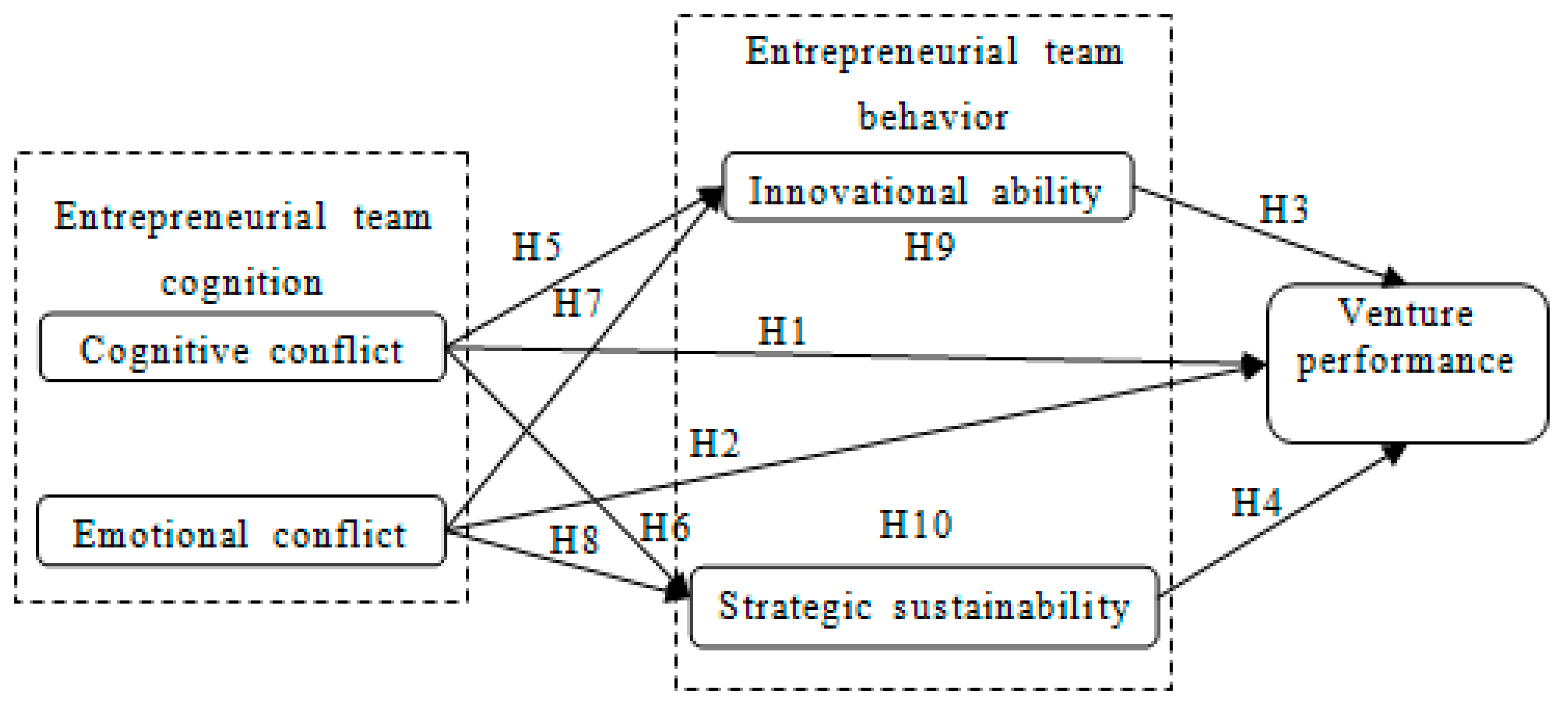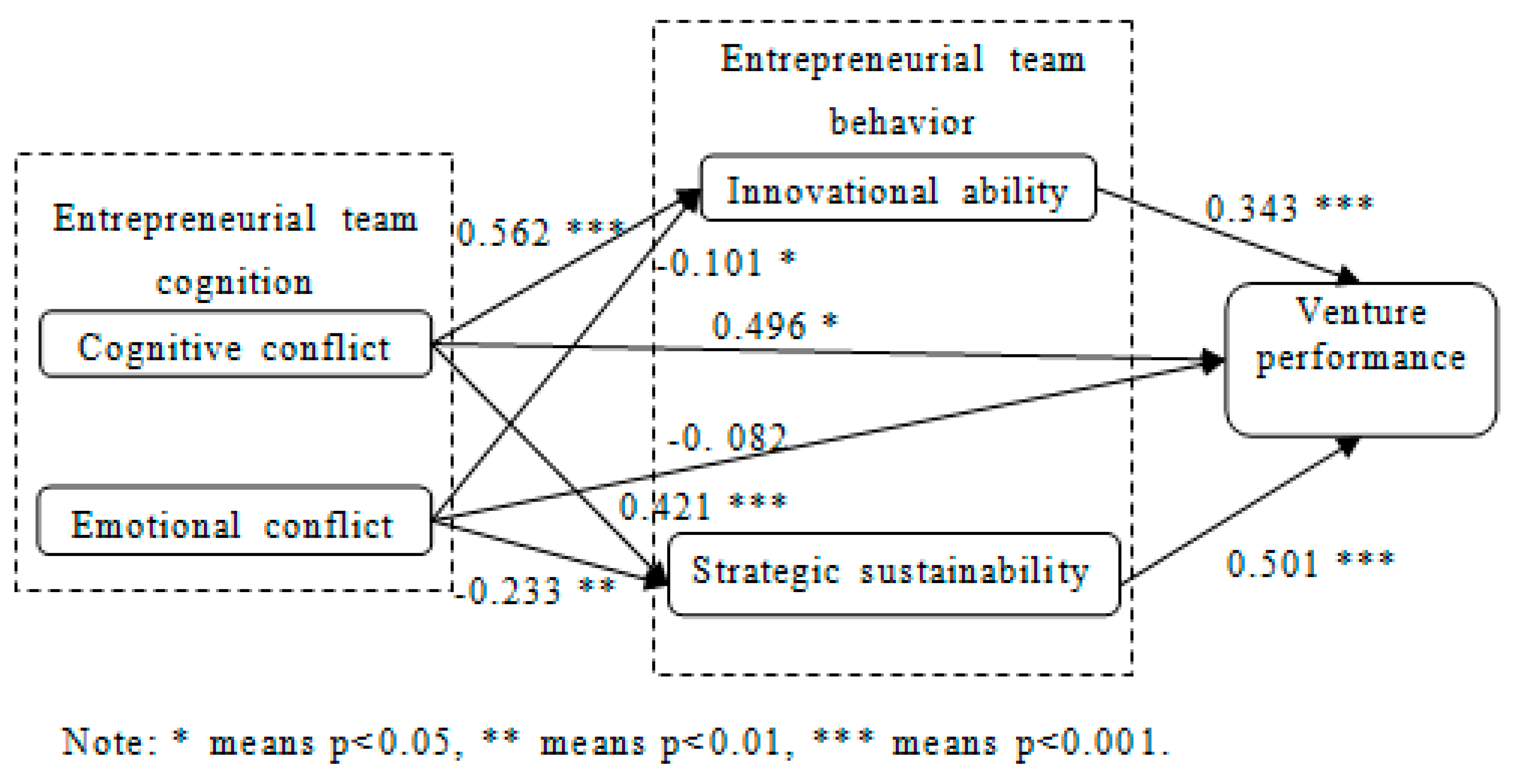Relationship between Entrepreneurial Team Characteristics and Venture Performance in China: From the Aspects of Cognition and Behaviors
Abstract
1. Introduction
2. Theoretical Basis and the Proposal of Research Hypothesis
2.1. Definition of Related Concepts
2.1.1. Entrepreneurial Teams and Their Characteristics
2.1.2. Venture Performance
2.2. Theoretical Analysis of the Relationship between the Cognition Characteristics and Venture Performance of an Entrepreneurial Team
2.3. Theoretical Analysis of the Relationship between the Behavior Characteristics and Venture Performance of an Entrepreneurial Team
2.4. Theoretical Analysis of the Relationship between the Cognition Characteristics and Behavior Characteristics of an Entrepreneurial Team
3. Research Method and Data Survey
3.1. Source and Process of Questionnaire Survey
3.2. Variable Measurement
3.2.1. Measurement of Entrepreneurial Team Characteristics
3.2.2. The Measurement of Venture Performance
4. Results
5. Discussion
5.1. Theoretical Contributions
5.2. Implications for Practice
5.3. Limitations and Future Research
6. Conclusions
Author Contributions
Funding
Conflicts of Interest
References
- Innovation and Entrepreneurship Policy Base. Available online: http://sc.ndrc.gov.cn/zhengceku.html (accessed on 26 December 2019).
- Singh, S.; Gaur, S. Entrepreneurship and innovation management in emerging economies. Manag. Decis. 2018, 56, 2–5. [Google Scholar] [CrossRef]
- Marcotte, C. Entrepreneurship and innovation in emerging economies: Conceptual, methodological and contextual issues. Int. J. Entrep. Behav. Res. 2014, 20, 42–65. [Google Scholar] [CrossRef]
- Kamm, J.B.; Shuman, J.C.; Seeger, J.A.; Nurick, A.J. Entrepreneurial teams in new venture creation: A research agenda. Entrep. Theory Pract. 1990, 14, 7–17. [Google Scholar] [CrossRef]
- Wang, L.; Tan, J.; Li, W. The impacts of spatial positioning on regional new venture creation and firm mortality over the industry life cycle. J. Bus. Res. 2018, 86, 41–52. [Google Scholar] [CrossRef]
- Kollmann, T.; Stöckmann, C.; Meves, Y.; Kensbock, J.M. When members of entrepreneurial teams differ: Linking diversity in individual-level entrepreneurial orientation to team performance. Small Bus. Econ. 2017, 48, 843–859. [Google Scholar] [CrossRef]
- Mol, E.D.; Khapova, S.N.; Elfring, T. Entrepreneurial team cognition: A review. Int. J. Manag. Rev. 2015, 17, 232–255. [Google Scholar] [CrossRef]
- Peng, X.L.; Huang, B.J.; Chen, H.P. Decoding the Spirit of Fujian Merchants. Fujian Daily. 18 June 2019. Available online: http://fjrb.fjsen.com/fjrb/html/2019-06/18/content_1190687.htm?div=-1 (accessed on 20 December 2019).
- Chen, S.S.; Liu, F. China Mass Entrepreneurship Index in 2016 (MEI-2016). Southwest Jiaotong University News. 12 September 2016. Available online: https://news.swjtu.edu.cn/ShowNews-12903-0-1.shtml (accessed on 25 December 2019).
- Jiang, Q.L. The 6thFujian Merchants Forum in 2019 Open. Xinhua Net. 18 June 2019. Available online: http://www.fj.xinhuanet.com/yuanchuang/2019-06/18/c_1124640094.htm (accessed on 20 December 2019).
- Introduction to Quanzhou, The People’s Government of Quanzhou Municipality Home Page. Available online: http://www.quanzhou.gov.cn/zfb/zjqz/qzgk/ (accessed on 26 December 2019).
- Introduction to Xiamen, The People’s Government of Xiamen Municipality Home Page. Available online: http://www.xm.gov.cn/zjxm/ (accessed on 26 December 2019).
- Iacobucci, D.; Rosa, P. The growth of business groups by habitual entrepreneurs: The role of entrepreneurial teams. Entrep. Theory Pract. 2010, 34, 351–377. [Google Scholar] [CrossRef]
- Klotz, A.C.; Veiga, S.P.D.M.; Buckley, M.R.; Gavin, M.B. The role of trustworthiness in recruitment and selection: A review and guide for future research. J. Organ. Behav. 2013, 34, 104–119. [Google Scholar] [CrossRef]
- Maschke, K.; Knyphausen-Aufseβ, D. How the entrepreneurial top management team setup influences firm performance and the ability to raise capital: A literature review. Bus. Res. 2012, 5, 83–123. [Google Scholar] [CrossRef]
- Chen, M.H.; Chang, Y.Y.; Chang, Y.C. The trinity of entrepreneurial team dynamics: Cognition, conflicts and cohesion. Int. J. Entrep. Behav. Res. 2017, 23, 934–951. [Google Scholar] [CrossRef]
- Gartner, W.B.; Shaver, K.G.; Gatewood, E. Finding the entrepreneur in entrepreneurship. Entrep. Theory Pract. 1994, 18, 5–10. [Google Scholar] [CrossRef]
- Ensley, M.D.; Carland, J.A.C. Exploring the existence of entrepreneurial teams. Int. J. Manag. 1999, 16, 276–281. [Google Scholar]
- Newbert, S.L. New Firm formation: A dynamic capability perspective. J. Small Bus. Manag. 2010, 43, 55–77. [Google Scholar] [CrossRef]
- Wdowiak, M.A.; Schwarz, E.J.; Breitenecker, R.J.; Wright, R.W. Linking the cultural capital of the entrepreneur and early performance of new ventures: A cross-country comparison. J. East Eur. Manag. Stud. 2012, 17, 149–183. [Google Scholar] [CrossRef]
- Mcgee, J.E.; Dowling, M.J.; Megginson, W.L. Cooperative strategy and new venture performance: The role of business strategy and management experience. Strateg. Manag. J. 2010, 16, 565–580. [Google Scholar] [CrossRef]
- Amason, A.C.; Sapienza, H.J. The effects of top management team size and interaction norms on cognitive and affective conflict. J. Manag. 1997, 23, 495–516. [Google Scholar] [CrossRef]
- Jehn, K.A.; Mannix, E.A. The dynamic nature of conflict: A longitudinal study of intragroup conflict and group performance. Acad. Manag. J. 2001, 44, 238–251. [Google Scholar]
- Roure, J.B.; Maidique, M.A. Linking prefunding factors and high-technology venture success: An exploratory study. J. Bus. Ventur. 2006, 1, 295–306. [Google Scholar] [CrossRef]
- Kamm, J.B.; Nurick, A.J. The stages of team venture formation: A decision-making model. Entrep. Theory Pract. 1993, 17, 17–27. [Google Scholar] [CrossRef]
- Carpenter, M.A. The implications of strategy and social context for the relationship between top management team heterogeneity and firm performance. Strateg. Manag. J. 2002, 23, 275–284. [Google Scholar] [CrossRef]
- Amason, A.C. Distinguishing the effects of functional and dysfunctional conflict on strategic decision making: Resolving a paradox for top management teams. Acad. Manag. J. 1996, 39, 123–148. [Google Scholar]
- Kuratko, D.F.; Ireland, R.D.; Hornsby, J.S. Improving firm performance through entrepreneurial actions: Acordia’s corporate entrepreneurship strategy. Acad. Manag. Perspect. 2001, 15, 60–71. [Google Scholar] [CrossRef]
- Covin, J.G.; Miles, M.P. Corporate entrepreneurship and the pursuit of competitive advantage. Entrep. Theory Pract. 1999, 23, 47–63. [Google Scholar] [CrossRef]
- Kurtzberg, T.R.; Mueller, J.S. The influence of daily conflict on perceptions of creativity: A longitudinal study. Int. J. Confl. Manag. 2005, 16, 335–353. [Google Scholar]
- Banerjee, S.B. Organisational strategies for sustainable development: Developing a research agenda for the new millennium. Aust. J. Manag. 2018, 27, 105–117. [Google Scholar] [CrossRef]
- Poblete, C.; Sena, V.; Fernandez de Arroyabe, J.C. How do motivational factors influence entrepreneurs’ perception of business opportunities in different stages of entrepreneurship? Eur. J. Work Organ. Psychol. 2019, 28, 179–190. [Google Scholar] [CrossRef]
- Dechurch, L.A.; Marks, M.A. Maximizing the benefits of task conflict: The role of conflict management. Int. J. Confl. Manag. 2001, 12, 4–22. [Google Scholar] [CrossRef]
- Chen, Y.; Pan, J. Do entrepreneurs’ developmental job challenges enhance venture performance in emerging industries? A mediated moderation model of entrepreneurial action learning and entrepreneurial experience. Front. Psychol. 2019, 10, 1371. [Google Scholar] [CrossRef]
- Fujian Provincial Bureau of Statistics, Fujian Statistical Yearbook. In Fujian Provincial People’s Government; 11 September 2019. Available online: http://tjj.fujian.gov.cn/tongjinianjian/dz2019/index.htm (accessed on 7 December 2019).
- Miller, D.; Friesen, P.H. Innovation in conservative and entrepreneurial firms: Two models of strategic momentum. Strateg. Manag. J. 1982, 3, 1–25. [Google Scholar] [CrossRef]
- Karagozoglu, N. Adaptive responses by conservative and entrepreneurial firms. J. Prod. Innov. Manag. 1988, 5, 269–281. [Google Scholar] [CrossRef]
- Taneja, H.; Chenault, K. Building a startup that will last. Harv. Bus. Rev. 2019, 7, 23–27. [Google Scholar]
- Hofstede, G. Culture and Organization: Software of the Mind; McGraw-Hill Press: New York, NY, USA, 2004. [Google Scholar]
- Delmar, F.; Shane, S. Legitimating first: Organizing activities and the survival of new ventures. J. Bus. Ventur. 2004, 19, 385–410. [Google Scholar] [CrossRef]
- Davidsson, P.; Honig, B. The role of social and human capital among nascent entrepreneurs. J. Bus. Ventur. 2003, 18, 301–331. [Google Scholar] [CrossRef]
- Parker, S.C.; Belghitar, Y. What happens to nascent entrepreneurs? An econometric analysis of the PSED. Small Bus. Econ. 2006, 27, 81–101. [Google Scholar] [CrossRef]
- Venkatraman, N.; Ramanujam, V. Measurement of business economic performance: An examination of method convergence. J. Manag. 1986, 8, 7858–7864. [Google Scholar] [CrossRef]
- Brown, R.L. Assessing specific mediational effects in complex theoretical models. Struct. Equ. Model. 1997, 4, 142–156. [Google Scholar] [CrossRef]


| Characteristic | Categories | Sample Number | Percentage Value |
|---|---|---|---|
| Sex | Male | 38 | 37.62% |
| Female | 63 | 62.38% | |
| Whether or Not the Individual is a Founding Member of the Company | Is a Founding Member | 69 | 68.32% |
| Is Not a Founding Member | 32 | 31.68% | |
| Age | 0–20 | 9 | 8.91% |
| 21–30 | 47 | 46.54% | |
| 30–50 | 39 | 38.61% | |
| 50+ | 6 | 5.94% | |
| How Long the Company has been Established | 0–1 | 27 | 26.73% |
| 2–5 | 59 | 58.42% | |
| 5–10 | 14 | 13.86% | |
| 10+ | 1 | 0.99% | |
| Main Market Channel for Company Operations | Internet | 31 | 30.69% |
| Direct-to-Customer | 13 | 12.87% | |
| Storefront | 46 | 45.55% | |
| Other | 11 | 10.89% |
| Variable | Item |
|---|---|
| The Cognitive Conflict of Team Members | Members of the original entrepreneurial team frequently have different opinions on how to manage the company |
| Disagreements among members of the original entrepreneurial team are, to a large extent, about work tasks | |
| Members of the original entrepreneurial team frequently have differing opinions on what course to take in managing the new company | |
| The Emotional Conflict of Team Members | There is obvious personality conflict among members of the original entrepreneurial team |
| Among members of the original entrepreneurial team, we see ourselves as partners who are collectively pushing our company towards success | |
| Members of the original entrepreneurial team do work tasks as if they are their own tasks | |
| Innovation Ability | We are the first company to introduce this product/service to the market |
| We are always looking for new opportunities related to our business | |
| Our team frequently keeps abreast of recent trends | |
| Strategic Sustainability | We are willing to sacrifice profits to increase market share |
| We take time to set a comprehensive business plan and then ensured that it is strictly administered | |
| We frequently test our business model on the market and adjust according to market feedback | |
| Venture Performance | Overall, we provided satisfactory investment returns to our founds and investors and arrived at our anticipated goal(s) |
| Our company reached our anticipated product or service development goal(s) | |
| Our company reached our anticipated user-based or customer-based goal(s) | |
| Our company reached our anticipated regional market entry goal(s) |
| Variable | Average Value | Standard Deviation | 1 | 2 | 3 | 4 | 5 |
|---|---|---|---|---|---|---|---|
| 1 Cognitive Conflict | 3.16 | 1.02 | 0.68 | ||||
| 2 Emotional Conflict | 3.46 | 0.86 | −0.32 ** | 0.66 | |||
| 3 Innovation Ability | 2.88 | 1.09 | 0.54 ** | −0.10 * | 0.69 | ||
| 4 Strategic Sustainability | 3.67 | 0.78 | 0.42 ** | −0.230 ** | 0.54 *** | 0.70 | |
| 5 Venture Performance | 3.84 | 0.83 | 0.469 *** | −0.154 | 0.343 *** | 0.503 *** | 0.72 |
© 2020 by the authors. Licensee MDPI, Basel, Switzerland. This article is an open access article distributed under the terms and conditions of the Creative Commons Attribution (CC BY) license (http://creativecommons.org/licenses/by/4.0/).
Share and Cite
Pei, X.-L.; Wu, T.-J.; Guo, J.-N.; Hu, J.-Q. Relationship between Entrepreneurial Team Characteristics and Venture Performance in China: From the Aspects of Cognition and Behaviors. Sustainability 2020, 12, 377. https://doi.org/10.3390/su12010377
Pei X-L, Wu T-J, Guo J-N, Hu J-Q. Relationship between Entrepreneurial Team Characteristics and Venture Performance in China: From the Aspects of Cognition and Behaviors. Sustainability. 2020; 12(1):377. https://doi.org/10.3390/su12010377
Chicago/Turabian StylePei, Xue-Liang, Tung-Ju Wu, Jia-Ning Guo, and Jia-Qi Hu. 2020. "Relationship between Entrepreneurial Team Characteristics and Venture Performance in China: From the Aspects of Cognition and Behaviors" Sustainability 12, no. 1: 377. https://doi.org/10.3390/su12010377
APA StylePei, X.-L., Wu, T.-J., Guo, J.-N., & Hu, J.-Q. (2020). Relationship between Entrepreneurial Team Characteristics and Venture Performance in China: From the Aspects of Cognition and Behaviors. Sustainability, 12(1), 377. https://doi.org/10.3390/su12010377





